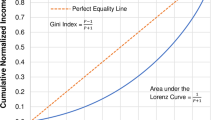Abstract
Zenga’s new inequality curve and index are two recent tools for measuring inequality. Proposed in 2007, they should thus not be mistaken for anterior measures suggested by the same author. This paper focuses on the new measures only, which are hereafter referred to simply as the Zenga curve and Zenga index. The Zenga curve Z(α) involves the ratio of the mean income of the 100α % poorest to that of the 100(1−α)% richest. The Zenga index can also be expressed by means of the Lorenz Curve and some of its properties make it an interesting alternative to the Gini index. Like most other inequality measures, inference on the Zenga index is not straightforward. Some research on its properties and on estimation has already been conducted but inference in the sampling framework is still needed. In this paper, we propose an estimator and variance estimator for the Zenga index when estimated from a complex sampling design. The proposed variance estimator is based on linearization techniques and more specifically on the direct approach presented by Demnati and Rao. The quality of the resulting estimators are evaluated in Monte Carlo simulation studies on real sets of income data. Finally, the advantages of the Zenga index relative to the Gini index are discussed.
Similar content being viewed by others
References
Alfons A, Holzer J, Templ M (2010) laeken: Laeken indicators for measuring social cohesion. R package version 0.1.3
Binder DA (1996) Linearization methods for single phase and two-phase samples: a cookbook approach. Surv Methodol 22: 17–22
Cowell FA, Victoria-Feser M-P (2003) Distribution-free inference for welfare indices under complete and incomplete information. J Econ Inequality 1: 191–219
Cowell FA (1977) Measuring inequality. Philip Allan, Oxford
Cowell FA, Flachaire E (2007) Income distribution and inequality measurement: the problem of extreme values. J Econom 141: 1044–1072
Cowell FA, Kuga K (1981) Inequality measurement: an axiomatic approach. Eur Econ Rev 15: 287–305
Cowell FA, Victoria-Feser M-P (1996) Poverty measurement with contaminated data: a robust approach. Eur Econ Rev 40: 1761–1771
Dagum C (1997) A new approach to the decomposition of the Gini income inequality ratio. Empir Econ 22: 515–531
Demnati A, Rao JNK (2004) Linearization variance estimators for survey data (with discussion). Surv Methodol 30: 17–34
Deville J-C (1999) Variance estimation for complex statistics and estimators: linearization and residual techniques. Surv Methodol 25: 193–204
Deville J-C, Särndal C-E (1992) Calibration estimators in survey sampling. J Am Stat Assoc 87: 376–382
Gastwirth JL (1972) The estimation of the Lorenz curve and Gini index. Rev Econ Stat 54: 306–316
Greselin F, Pasquazzi L, and Zitikis R (2010) Zenga’s new index of economic inequality, its estimation, and an analysis of incomes in Italy. J Probab Stat, ID 718905:1–26
Greselin F, Puri M, Zitikis R (2009) L-functions, processes, and statistics in measuring economic inequality and actuarial risks. Stat Interfaces 2: 227–245
Hampel FR (1974) The influence curve and its role in robust estimation. J Am Stat Assoc 69: 383–393
Hampel FR, Ronchetti E, Rousseuw PJ, Stahel W (1985) Robust statistics: the approach based on the influence function. Wiley, New York
Hulliger, B, Schoch, T (eds) (2009) Robustification of the quintile share ratio. In: Proceedings of the Colloque sur les méthodes de sondage en l’honneur de Jean-Claude Deville, Neuchâtel, Switzerland
Isaki CT, Fuller WA (1982) Survey design under a regression population model. J Am Stat Assoc 77: 89–96
Kovacevic MS, Binder DA (1997) Variance estimation for measures of income inequality and polarization—the estimating equations approach. J Off Stat 13: 41–58
Langel M, Tillé Y (2009) An evaluation of the performance of inequality measures for the detection of changes in an income distribution. Technical report, University of Neuchatel
Langel M, Tillé Y (2011a) Corrado Gini, a pioneer in balanced sampling and inequality theory. Metron 69: 43–63
Langel M, Tillé Y (2011b) Statistical inference for the quintile share ratio. J Stat Plan Inference 141: 2976–2985
Lorenz MO (1905) Methods of measuring the concentration of wealth. Publ Am Stat Assoc 9: 209–219
Maffenini W, Polisicchio M (2010) How potential is the I(p) inequality curve in the analysis of empirical distributions. Technical report, Technical report, Universita degli Studi di Milano-Bicocca
Monti AC (1991) The study of the Gini concentration ratio by means of the influence function. Statistica 51: 561–577
Polisicchio M (2008) The continuous random variable with uniform point inequality measure I(p). Statistica e Applicazioni 6: 137–151
R Development Core Team (2010) R: a language and environment for statistical computing. R Foundation for statistical computing, Vienna, Austria. ISBN 3-900051-07-0
Radaelli P (2008) A subgroups decomposition of Zenga’s uniformity and inequality indexes. Statistica e Applicazioni 6: 117–136
Radaelli P (2010) On the decomposition by subgroups of the Gini index and Zenga’s uniformity and inequality indexes. Int Stat Rev 78: 81–101
Woodruff RS (1971) A simple method for approximating the variance of a complicated estimate. J Am Stat Assoc 66: 411–414
Zenga M (1984) Proposta per un indice di concentrazione basato sui rapporti tra quantili di popolazione e quantili di reddito. Giornale degli Economisti e Annali di Economia 43: 301–326
Zenga M (2007) Inequality curve and inequality index based on the ratios between lower and upper arithmetic means. Statistica e Applicazioni 4: 3–27
Author information
Authors and Affiliations
Corresponding author
Rights and permissions
About this article
Cite this article
Langel, M., Tillé, Y. Inference by linearization for Zenga’s new inequality index: a comparison with the Gini index. Metrika 75, 1093–1110 (2012). https://doi.org/10.1007/s00184-011-0369-1
Received:
Published:
Issue Date:
DOI: https://doi.org/10.1007/s00184-011-0369-1



